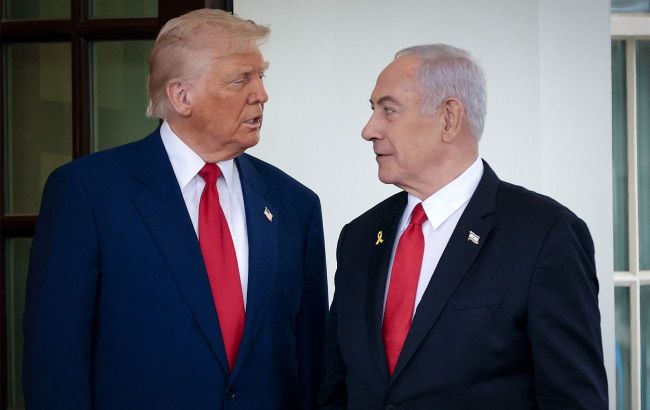Peace in Gaza at last? Inside Trump's deal between Hamas and Israel
 Donald Trump and Benjamin Netanyahu (Photo: Getty Images)
Donald Trump and Benjamin Netanyahu (Photo: Getty Images)
The war in the Gaza Strip, which once seemed endless, may suddenly be coming to an end. Israel and Hamas militants have agreed to President Donald Trump's peace plan — and even begun to implement it.
RBC-Ukraine reports on how the current deal differs from previous attempts to end the war in Gaza and why this time there may be a real chance for success.
US President Donald Trump unveiled his plan to settle the conflict between Israel and Hamas on September 29. It includes 20 provisions — some short-term goals such as the release of Israeli hostages and Palestinian prisoners, and others aimed at restoring normal life in the Gaza Strip over the longer term.
After the plan was announced, Hamas took several days to consider it but eventually agreed to proceed with the first phase. The Israeli government ratified the agreement to implement the initial stage of the plan on the night of October 10.
Under the agreement, the Israel Defense Forces (IDF) began withdrawing troops to designated positions – the so-called "yellow line" – while continuing to control more than half of the Gaza Strip. Within 72 hours, by Monday, Hamas militants are expected to release twenty surviving hostages simultaneously, without any public ceremonies. The bodies of those killed will be handed over in stages.
In return, Israel will release 2,000 Palestinian prisoners, excluding members of groups involved in the October 7, 2023 terrorist attack, as well as four individuals including the notorious militant Marwan Barghouti, whose release Hamas had demanded during negotiations.
In the coming days, Israel will also allow the delivery of 600 truckloads of humanitarian aid to the Gaza Strip daily. In addition, a coordination mechanism will be established jointly with Egypt to enable the return of Palestinian refugees to Gaza.
Pressure on Hamas and Israel
Hamas took more than 250 hostages on October 7, 2023, during the deadliest terrorist attack in Israel's history, which also killed around 1,200 people. In response, Israel launched a military operation in the Hamas-controlled Gaza Strip, significantly weakening the group – though it failed to completely destroy it. One major reason for that was the hostages themselves.
The militants used them as "human shields," limiting the Israeli army's operational capabilities. From the very beginning, freeing the hostages was one of the IDF's main objectives in its campaign against Hamas. Realizing that the group would lose its leverage over Israel once the hostages were released, Hamas repeatedly derailed broader agreements with the Jewish state.
Now, Hamas finds itself in a much weaker position than before. The Israeli operation has eliminated most of the group's experienced commanders and much of its military infrastructure in Gaza. At the same time, international pressure on Hamas has intensified – including from some of its former sponsors. All of this became additional motivation for the group to finally agree to Trump's plan.
"We felt that Hamas was at a place… where [it] was looking at the hostages less as an asset and more as a liability," a senior US official told The Times of Israel.
On the other hand, Israel is also facing significant pressure from the international community. In September, several Western European countries organized a wave of recognition of Palestine as an independent state, sending a diplomatic signal to Israel. The reaction in Israel was rather muted.
Much greater pressure on the Israeli government is coming from the United States. Donald Trump has long sought to bring this war to an end. Moreover, a deal between Israel and Hamas could have boosted his chances of winning the Nobel Peace Prize, though he ultimately did not receive it. During the ratification of the agreement with Hamas, US presidential envoy Stephen Witkoff and Trump's son-in-law Jared Kushner joined the Israeli government meeting.
What's next for Gaza
Most countries in the region have expressed support for Trump's plan. The most important among them, in the context of the conflict, are the Gulf monarchies, which could eventually fund Gaza’s reconstruction, and Egypt, which borders the enclave.
For Hamas, the plan is the best possible outcome. The alternative, if the deal collapsed, would be the group's complete destruction, sooner or later. Overall, the plan also benefits Israel. However, once peace takes hold, new challenges could emerge personally for Prime Minister Benjamin Netanyahu, from growing public calls for new elections to investigations into how the October 7 attack was even possible.
Witkoff and Kushner are expected to remain in Israel during the release of hostages early next week to ensure proper implementation of the deal. A visit from Donald Trump himself to Israel over the weekend is also possible.
"We want to make sure that we get to the withdrawal, the ceasefire, and then we get to a place for the hostages to return home and for the exchange to be done. Then we’ll go into the next phase, which is figuring out what comes next in Gaza," Jared Kushner said in Israel.
Regardless of how events unfold, whether Hamas lays down arms or fighting continues, it does not necessarily mean a political defeat for the group, at least not yet. It's clear that Hamas will not be allowed direct participation in political processes in the Palestinian territories, but its ideology may persist, possibly under a different banner.
In this regard, the key remains eliminating the militants' social base through rebuilding Gaza’s economy, integrating it into regional structures, and establishing transparent governing institutions. All of this is mentioned in Trump’s 20-point plan, but the prospects for implementing such an ambitious vision remain uncertain.
Sources: statements from US and Middle Eastern officials, as well as reports from Axios, Politico, Reuters, and The Times of Israel.

